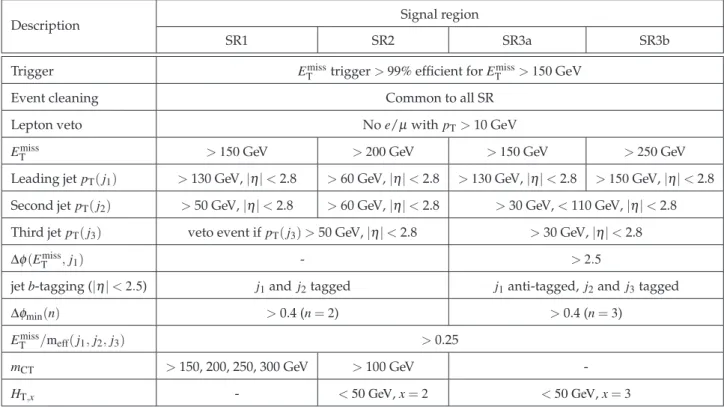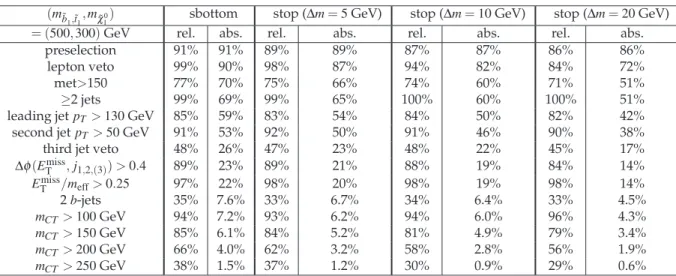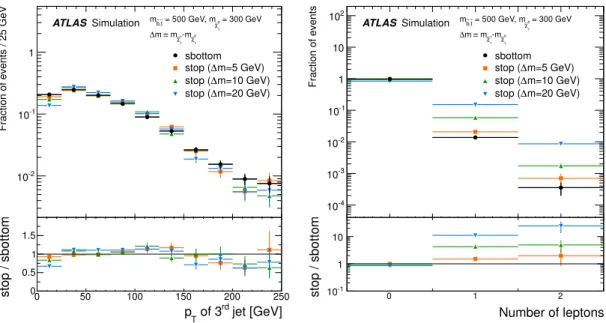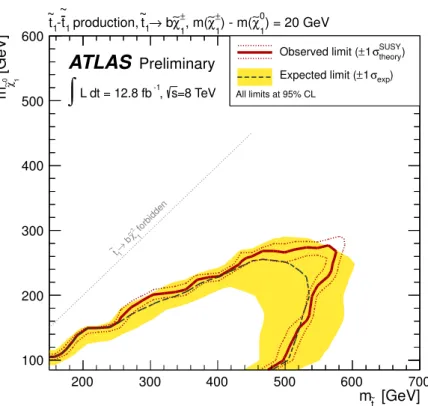ATLAS-CONF-2013-001 07/01/2013
ATLAS NOTE
ATLAS-CONF-2013-001
21 December 2012 Minor revision: 5 January 2013
Search for direct stop production in events with missing transverse momentum and two b-jets using 12.8 fb
−1of pp collisions at
√ s = 8 TeV with the ATLAS detector
The ATLAS Collaboration
Abstract
The results of the search for direct pair production of bottom squarks are reinter- preted in terms of direct pair production of top squarks decaying exclusively into a bottom quark and a chargino. The dataset used corresponds to an integrated lumi- nosity of 12.8
fb−1of
ppcollisions at
√s=8
TeV recorded by the ATLAS detector at the LHC. Assuming that the mass difference between the chargino and the lightest neutralino is small (
.5GeV), top squarks with masses
<580GeV are excluded at 95% confidence level for
mχ˜10 ≃100GeV and neutralino masses up to 300 GeV are excluded for
mt˜1 ≃500GeV. In the case of larger mass differences (
.20GeV) the top squark and neutralino mass limits weaken by up to 100 GeV.
Note number revised on 5 January 2013
c Copyright 2013 CERN for the benefit of the ATLAS Collaboration.
Reproduction of this article or parts of it is allowed as specified in the CC-BY-3.0 license.
1 Introduction
Supersymmetry (SUSY) [1–9] provides a solution to the hierarchy problem of the Standard Model (SM) by introducing supersymmetric partners of the known bosons and fermions [10–
13]. In
R-parity conserving SUSY scenarios SUSY particles are produced in pairs at the LHC.
Each SUSY particle subsequently decays (possibly via intermediate SUSY particles) to Standard Model particles and a lightest supersymmetric particle (LSP), which is stable. This generically results in collider signatures with relatively large missing transverse momentum.
Naturalness arguments [14–16] require the masses of the superpartners closely connected to the Higgs sector to be near the electroweak scale. In particular, the lightest of the third genera- tion squarks (the stop and sbottom), the fermionic partners of the Higgs bosons (the higgsinos), and to a lesser extent, the partner of the gluon (the gluino) are required to be relatively light.
The other SUSY particles, on the other hand, are not constrained by naturalness criteria, and may have masses much larger than 1 TeV.
A search for pair production of the lightest sbottom particle (
b˜1), each decaying into a bot- tom quark (b) and a neutralino (
χ˜10) has been recently performed in ATLAS [17]. Pair produced stops (
t˜1) may mimic this signature if they decay into a
b-quark and a chargino (
χ˜1±), and the mass difference between the chargino and the neutralino is small. This possibility is a general feature of scenarios where the LSP is mainly higgsino or wino, and the other gauginos are much heavier.
In this note, the search for the pair production of bottom squarks presented in Ref. [17] is reinterpreted in terms of stop pair production. A simplified scenario is considered, in which the stop decays exclusively via
t˜1→bχ˜1+, and
χ˜1+decays via
χ˜1+ →W∗χ˜10→χ˜10ff¯′, with
fand
f′representing different fermion types according to the SM branching ratios of the
Wboson.
In case of small values for
∆m≡mχ˜1+−mχ˜10,
fand
f′are soft and may have transverse mo- menta below the reconstruction thresholds applied in the analysis. This leads to the final state signature of two
b-tagged jets andETmissfor which the sbottom pair production was designed.
Two different values of
∆mare considered: 5 GeV and 20 GeV. In addition, a few models with
∆m=10
GeV are considered to evaluate the analysis efficiency in an intermediate scenario. In this study, only models that are not excluded by the LEP lower limit on the chargino mass of 103.5 GeV [18] are considered.
In Section 2, differences in selection efficiency between top squark pair events and bottom squark pair events are discussed. The results are presented in Section 3, and conclusions are given in Section 4.
2 Comparison with the search for sbottom pair events
Since differences between stop and sbottom production cross sections are negligible [19], the
main difference between the analysis sensitivities is the eventual change in acceptances. A
summary of the different signal regions considered in the analysis of Ref. [17] can be found
in Table 1. The sensitivity of this analysis (optimised for sbottom pair production) to stop
pair production depends strongly on
∆m. For a small mass splitting, the signal acceptance
Description Signal region
SR1 SR2 SR3a SR3b
Trigger ETmisstrigger>99%efficient forETmiss>150GeV
Event cleaning Common to all SR
Lepton veto Noe/µwithpT>10 GeV
ETmiss >150GeV >200GeV >150GeV >250GeV
Leading jetpT(j1) >130 GeV,|η|<2.8 >60 GeV,|η|<2.8 >130GeV,|η|<2.8 >150GeV,|η|<2.8 Second jetpT(j2) >50 GeV,|η|<2.8 >60 GeV,|η|<2.8 >30 GeV,<110 GeV,|η|<2.8 Third jetpT(j3) veto event ifpT(j3)>50 GeV,|η|<2.8 >30 GeV,|η|<2.8
∆φ(ETmiss,j1) - >2.5
jetb-tagging (|η|<2.5) j1andj2tagged j1anti-tagged, j2andj3tagged
∆φmin(n) >0.4 (n=2) >0.4 (n=3)
ETmiss/meff(j1,j2,j3) >0.25
mCT >150, 200, 250, 300 GeV >100 GeV -
HT,x - <50 GeV,x=2 <50 GeV,x=3
Table 1: Summary of the event selection in each signal region. The leading, subleading and 3rd leading jet are referred to as
j1,
j2and
j3, respectively.
Table 2 compares the SR1 selection efficiencies for sbottom pair production and stop pair production models with
mb˜1,t˜1=500
GeV,
mχ˜10 =300GeV, and
∆m=5GeV, 10 GeV and 20 GeV.
For stop pair production, the fraction of events passing the lepton veto decreases with increas- ing
∆m, due to the presence of additional leptons passing the object identification criteria. Theremaining selection steps, including the veto on the third jet, have similar efficiencies for all the samples considered.
The distributions of the third hardest jet and the number of leptons are shown in Figure 1, comparing the models considered in Table 2. Figure 2 shows the distributions of the
HT,nvari- ables used in SR2 and SR3, for models with
mb˜1,t˜1 =600
GeV,
mχ˜10 =100GeV and
mb˜1,˜t1 =500
GeV,
mχ˜10=450GeV. The efficiencies of selections on the
HT,n(n=2,3)variables used in SR2 and SR3 agree within a few percent for the sbottom and the corresponding stop pair sample with
∆m=5
GeV. With larger
∆m, however, the difference in efficiency can be large. For example,with
mt˜=600GeV,
mχ˜10 =100GeV and
∆m=20GeV, the
HT,2<50GeV selection criterion is found to reduce the stop signal event yield by a factor of two compared to the corresponding sbottom scenario.
3 Results and interpretation
The results are interpreted in stop pair production scenarios in which the stop is assumed to
decay via
t˜1→bχ˜1+with a 100% branching ratio. The mass difference between
χ˜1+and
χ˜10is
taken to be either 5 or 20 GeV. The signal samples are generated using
MADGRAPH[20] interfaced
to Pythia 6 [21], using the PDF set
CTEQ6L1[22].
(m˜b1,t˜1,mχ˜10) sbottom stop (∆m=5GeV) stop (∆m=10GeV) stop (∆m=20GeV)
= (500,300)GeV rel. abs. rel. abs. rel. abs. rel. abs.
preselection 91% 91% 89% 89% 87% 87% 86% 86%
lepton veto 99% 90% 98% 87% 94% 82% 84% 72%
met>150 77% 70% 75% 66% 74% 60% 71% 51%
≥2 jets 99% 69% 99% 65% 100% 60% 100% 51%
leading jetpT>130GeV 85% 59% 83% 54% 84% 50% 82% 42%
second jetpT>50GeV 91% 53% 92% 50% 91% 46% 90% 38%
third jet veto 48% 26% 47% 23% 48% 22% 45% 17%
∆φ(ETmiss,j1,2,(3))>0.4 89% 23% 89% 21% 88% 19% 84% 14%
ETmiss/meff>0.25 97% 22% 98% 20% 98% 19% 98% 14%
2b-jets 35% 7.6% 33% 6.7% 34% 6.4% 33% 4.5%
mCT>100GeV 94% 7.2% 93% 6.2% 94% 6.0% 96% 4.3%
mCT>150GeV 85% 6.1% 84% 5.2% 81% 4.9% 79% 3.4%
mCT>200GeV 66% 4.0% 62% 3.2% 58% 2.8% 56% 1.9%
mCT>250GeV 38% 1.5% 37% 1.2% 30% 0.9% 29% 0.6%
Table 2: Selection efficiencies for a sbottom signal point with
mb˜1=500
GeV and
mχ˜10 =300GeV (second and third columns), and three stop signal points with
mt˜1=500GeV,
mχ˜10=300GeV for
∆m=5
GeV, 10 GeV and 20 GeV. The absolute selection efficiencies are computed with respect to the total number of simulated events, whereas relative efficiencies are computed with respect to the previous selection criterion. All numbers are extracted from samples whose total size is roughly 10000 events.
Experimental and theoretical uncertainties on the signal are included using the prescrip- tions discussed in Ref. [17].
The 95% confidence level (C.L.) exclusion limits obtained using the
CLsprescription [23] are shown in Fig. 3 for
∆m=5GeV and in Fig. 4 for
∆m=20GeV. The signal region with the best expected
CLsexclusion limit is used to derive the limit for each signal point.
If
mχ˜10=100GeV, stop quark masses up to 580 GeV are excluded at 95% C.L. for
∆m=5GeV and 480 GeV for
∆m=20GeV. Assuming
∆m=5(∆m
=20) GeV, neutralino masses up to 300 (250) GeV are excluded for
mt˜1 =500(480)GeV.
4 Conclusions
The results of Ref. [17], based on 12.8 fb
−1of
√s=8
TeV
ppcollision data recorded by the ATLAS detector, are interpreted in scenarios where pair produced stops decay into a chargino and a bottom quark.
For
mχ˜10=100GeV, stop masses up to 580 GeV are excluded at 95% C.L. for
∆m=5GeV and
480 GeV for
∆m=20GeV. Assuming
∆m=5GeV, neutralino masses up to 300 GeV are excluded
for
mt˜1 =500GeV. Assuming
∆m=20GeV, neutralino masses up to 250 GeV are excluded for
mt˜1 =480GeV.
0 50 100 150 200 250
Fraction of events / 25 GeV
10-2
10-1
1 sbottom
m=5 GeV)
∆ stop (
m=10 GeV)
∆ stop (
m=20 GeV)
∆ stop (
= 300 GeV
0 1
= 500 GeV, mχ∼
~t ,
~b
m
0 1
-mχ∼
± 1
mχ∼
m ≡
∆ ATLAS Simulation
jet [GeV]
of 3rd
pT
0 50 100 150 200 250
stop / sbottom 0
0.5 1
1.5 0 0.5 1 1.5 2 2.5 3
Fraction of events
10-4
10-3
10-2
10-1
1 10 102
sbottom m=5 GeV)
∆ stop (
m=10 GeV)
∆ stop (
m=20 GeV)
∆ stop (
= 300 GeV
0 1
= 500 GeV, mχ∼
~t , b~
m
0 1
-mχ∼
± 1
mχ∼
m ≡
∆ ATLASSimulation
Number of leptons
0 1 2
stop / sbottom -110
1 10
Figure 1: Comparison of distributions (normalised to unit area) for a sbottom signal point with
mb˜1 =500
GeV and
mχ˜10 =300GeV, and three stop signal points with
mt˜1 =500GeV,
mχ˜10=300GeV and
∆m=5GeV, 10 GeV and 20 GeV. The
pTof the third highest momentum jet (left)
and the number of electrons and muons with
pT >10GeV (right). The distribution of the
pTof the third highest momentum jet is produced after requiring all selection criteria up to
and including the
pT >50GeV requirement on the second jet in Table 2. The distribution of
the number of leptons is produced after the preselection. Only statistical uncertainties arising
from the limited size of simulated samples are shown. The bottom panel in each plot shows
the ratios of the histogram entries from the stop pair samples and the sbottom pair sample. The
final bin in the histograms includes the overflow.
0 50 100 150 200 250 300
Fraction of events / 30 GeV
10-3
10-2
10-1
1 sbottom
m=5 GeV)
∆ stop (
m=20 GeV)
∆ stop (
= 100 GeV
0 1
= 600 GeV, mχ∼
~t ,
~b
m
0 1
-mχ∼
± 1
mχ∼
≡
∆m ATLAS Simulation
[GeV]
HT,2
0 50 100 150 200 250 300
stop / sbottom
1 2 3
0 50 100 150 200 250 300
Fraction of events / 30 GeV
10-2
10-1
1 10
sbottom m=5 GeV)
∆ stop (
m=20 GeV)
∆ stop (
= 450 GeV
0 1
= 500 GeV, mχ∼
~t , b~
m
0 1
-mχ∼
± 1
mχ∼
≡
∆m ATLASSimulation
[GeV]
HT,3
0 50 100 150 200 250 300
stop / sbottom 0
0.5 1 1.5
Figure 2: Comparison of distributions normalised to unit area for a sbottom pair signal point and two stop pair signal points with
∆m=5and 20 GeV. Left:
HT,2distribution for
mb˜1 =mt˜1 = 600
GeV and
mχ˜10=100GeV. Right:
HT,3distribution for
mb˜1=mt˜1=500
GeV and
mχ˜10=450GeV.
The distribution of
HT,2is produced after requiring all selection criteria up to and including the
pT >50GeV requirement on the second jet in Table 2. The distribution of
HT,3is produced after requiring the leading jet to have
pT >130GeV and two additional jets with
pT>30GeV.
Only statistical uncertainties arising from the limited size of simulated samples are shown. The
bottom panel in each plot shows the ratios of the histogram entries from the stop pair samples
to the sbottom pair sample. The final bin in the histograms includes the overflow.
[GeV]
t1
m~
200 300 400 500 600 700
[GeV]0 1χ∼m
100 150 200 250 300 350 400 450 500 550 600
forbidden
1
±χ b∼
→1
~t
) = 5 GeV
1
χ∼0
) - m(
1
χ∼± 1, m(
χ∼±
→ b t1
production, ~ t1
~
1-
~t
ATLAS
Preliminary=8 TeV s
-1, L dt = 12.8 fb
∫
theory) σSUSY
±1 Observed limit (
exp) σ
±1 Expected limit ( All limits at 95% CL
Figure 3: Expected and observed 95% C.L. exclusion limits in the
mt˜1−mχ˜10plane for
∆m=5GeV. The black, dashed line shows the expected limit if theoretical uncertainties on the signal
are neglected. The yellow band shows the
±1σuncertainty on the expected limit. The red solid
line shows the nominal observed limit, while the red dashed lines show its variation if theory
uncertainties on the signal are taken into account.
[GeV]
t1
m~
200 300 400 500 600 700
[GeV]0 1χ∼m
100 200 300 400 500 600
forbidden
1
±χ
∼
→1 b
~t
) = 20 GeV
1
χ∼0
) - m(
1
χ∼± 1, m(
χ∼±
→ b t1
production, ~ t1
~
1-
~t
ATLAS
Preliminary=8 TeV s
-1, L dt = 12.8 fb
∫
theory) σSUSY
±1 Observed limit (
exp) σ
±1 Expected limit ( All limits at 95% CL
Figure 4: Expected and observed 95% C.L. exclusion limits in the
mt˜1−mχ˜10plane for
∆m=20GeV. The black, dashed line shows the expected limit if theoretical uncertainties on the signal
are neglected. The yellow band shows the
±1σuncertainty on the expected limit. The red solid
line shows the nominal observed limit, while the red dashed lines show its variation if theory
uncertainties on the signal are taken into account.
A Auxiliary material
[GeV]
b1
or m~ t1
m~
200 300 400 500 600 700
[GeV]0 1χ∼m
100 200 300 400 500 600
) + 5 GeV < 103.5 GeV
1
χ∼0
m(
forbidden
1 0χ b∼
→1
~b or
1
±χ b∼
→1
~t
production b1
-~ b1
or ~ t1
-~ t1
~
ATLAS
Preliminary=8 TeV s
-1, L dt = 12.8 fb
∫
expected observed expected observed expected observed
1
χ∼±
→ b t1
production, ~ t1
-~ t1
~
) = 5 GeV
0
χ∼1
±, χ∼1
∆m(
1
χ∼±
→ b t1
production, ~ t1
-~ t1
~
) = 20 GeV
0
χ∼1
±, χ∼1
∆m(
1
χ∼0
→ b b1
production, ~ b1
-~ b1
~
ATLAS-CONF-2012-165
not included
theory
σSUSY
All limits at 95% CL,
Figure 5: Expected and observed 95% C.L. exclusion limits on sbottom pair production in the
mb˜1−mχ˜10plane, together with the expected and observed 95% C.L. exclusion limits for stop
pair production in the
m˜t1−mχ˜10plane for
∆m=5GeV and 20 GeV. The theory uncertainty on
the signal is not shown.
[GeV]
t1
m~
200 300 400 500 600 700
[GeV]0 1χ∼m
100 150 200 250 300 350 400 450 500 550 600
Numbers give 95% CL excluded model cross sections [pb]
forbidden
1
±χ
∼
→1 b
~t
0.03
0.02
0.03
0.18 0.03
3.1
0.64
16
0.03
0.02 0.02 132
0.25 37
0.23
0.32
2.8
0.92
6.1
0.03
0.06
0.08 0.26
0.09 1.1
0.91
0.02 0.43
0.09
0.02
0.02 0.52
0.25
0.03
12
0.02 0.58
0.42 98
3.5
0.03
0.02 0.08 0.55
0.71
0.02
0.14 50
1.7
0.03 261
3.0
4.6
1.5
0.19
0.02 3.9
0.06
0.03 0.07
0.02 0.04 0.04
) = 5 GeV
1
χ∼0
) - m(
1
χ∼± 1, m(
χ∼±
→ b t1
production, ~ t1
~
1-
~t
ATLAS
Preliminary=8 TeV s
-1, L dt = 12.8 fb
∫
theory) σSUSY
±1 Observed limit (
exp) σ
±1 Expected limit ( All limits at 95% CL
Figure 6: Expected and observed 95% C.L. exclusion limits in the
mt˜1−mχ˜10plane for
∆m=5GeV. The black, dashed line shows the expected limit if theory uncertainties on the signal are
neglected. The yellow band shows the
±1σuncertainty on the expected limit. The red solid
line shows the nominal observed limit, while the red dashed lines show its variation if theory
uncertainties on the signal are taken into account. The overlaid numbers give the observed
upper limit on the signal cross section, in pb. For clarity, numbers of the first row (column)
have been shifted upwards (right) by 10 GeV.
[GeV]
t1
m~
200 300 400 500 600 700
[GeV]0 1χ∼m
100 200 300 400 500 600
Numbers give 95% CL excluded model cross sections [pb]
forbidden
1
±χ
∼
→ b t1
~
0.07
0.09 0.07
0.09
0.40 0.08
5.4
2.2
0.04
0.05 0.04 0.64
0.50
0.09 0.77
3.4
19
0.10
0.13 0.68
0.12 2.1
3.6
0.04 25
1.1
0.22
0.04
0.05 0.49
0.81
0.06 34
0.06 1.0
1.1
0.03
11
0.08
0.09 353
0.14 1.1
1.8
0.05
0.27
5.8
8.4
6.1
0.10 105
5.6
8.9
2.7 2.3
0.50
0.04
0.10
172
0.06 0.11
0.04 0.03 0.03
) = 20 GeV
1
χ∼0
) - m(
1
χ∼± 1, m(
χ∼±
→ b t1
production, ~ t1
~
1-
~t
ATLAS
Preliminary=8 TeV s
-1, L dt = 12.8 fb
∫
theory) σSUSY
±1 Observed limit (
exp) σ
±1 Expected limit ( All limits at 95% CL
Figure 7: Expected and observed 95% C.L. exclusion limits in the
mt˜1−mχ˜10plane for
∆m=20GeV. The black, dashed line shows the expected limit if theory uncertainties on the signal are
neglected. The yellow band shows the
±1σuncertainty on the expected limit. The red solid
line shows the nominal observed limit, while the red dashed lines show its variation if theory
uncertainties on the signal are taken into account. The overlaid numbers give the observed
upper limit on the signal cross section, in pb. For clarity, the first column number has been
shifted right by 10 GeV.
References
[1] H. Miyazawa, Baryon Number Changing Currents, Prog. Theor. Phys.
36 (6)(1966) 1266–1276.
[2] P. Ramond, Dual Theory for Free Fermions, Phys. Rev.
D3(1971) 2415–2418.
[3] Y. A. Gol’fand and E. P. Likhtman, Extension of the Algebra of Poincare Group Generators and Violation of p Invariance, JETP Lett.
13(1971) 323–326. [Pisma
Zh.Eksp.Teor.Fiz.13:452-455,1971].
[4] A. Neveu and J. H. Schwarz, Factorizable dual model of pions, Nucl. Phys.
B31(1971) 86–112.
[5] A. Neveu and J. H. Schwarz, Quark Model of Dual Pions, Phys. Rev.
D4(1971) 1109–1111.
[6] J. Gervais and B. Sakita, Field theory interpretation of supergauges in dual models, Nucl. Phys.
B34
(1971) 632–639.
[7] D. V. Volkov and V. P. Akulov, Is the Neutrino a Goldstone Particle?, Phys. Lett.
B46(1973) 109–110.
[8] J. Wess and B. Zumino, A Lagrangian Model Invariant Under Supergauge Transformations, Phys. Lett.
B49(1974) 52.
[9] J. Wess and B. Zumino, Supergauge Transformations in Four-Dimensions, Nucl. Phys.
B70(1974) 39–50.
[10] S. Weinberg, Implications of Dynamical Symmetry Breaking, Phys. Rev.
D13(1976) 974–996.
[11] E. Gildener, Gauge Symmetry Hierarchies, Phys. Rev.
D14(1976) 1667.
[12] S. Weinberg, Implications of Dynamical Symmetry Breaking: An Addendum, Phys. Rev.
D19(1979) 1277–1280.
[13] L. Susskind, Dynamics of Spontaneous Symmetry Breaking in the Weinberg- Salam Theory, Phys. Rev.
D20(1979) 2619–2625.
[14] R. Barbieri and G. Giudice, Upper Bounds on Supersymmetric Particle Masses, Nucl.Phys.
B306
(1988) 63.
[15] B. de Carlos and J. Casas, One loop analysis of the electroweak breaking in supersymmetric models and the fine tuning problem, Phys.Lett.
B309(1993) 320–328,
arXiv:hep-ph/9303291 [hep-ph]








